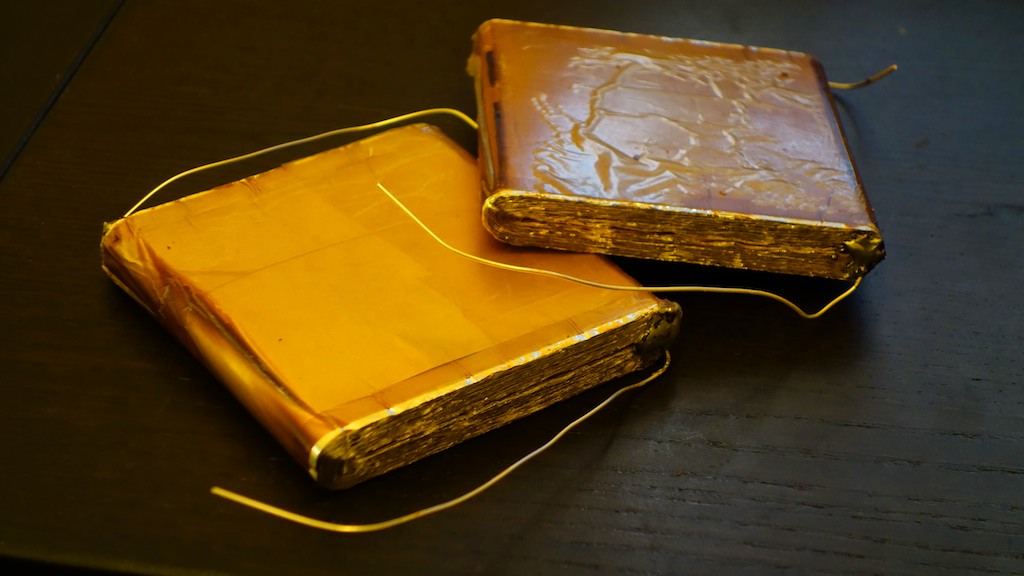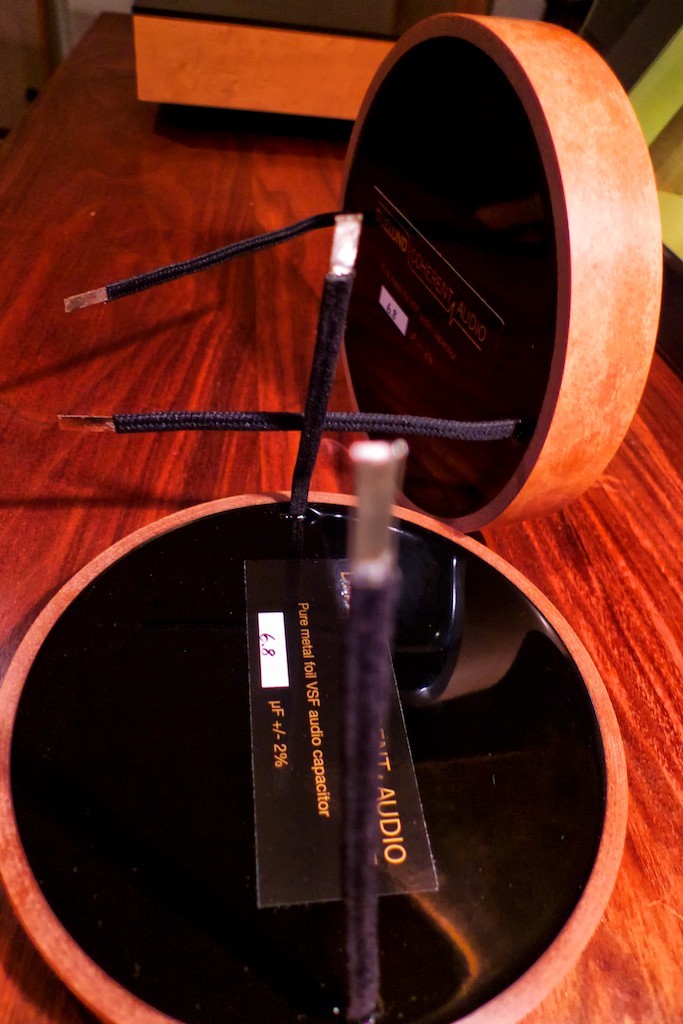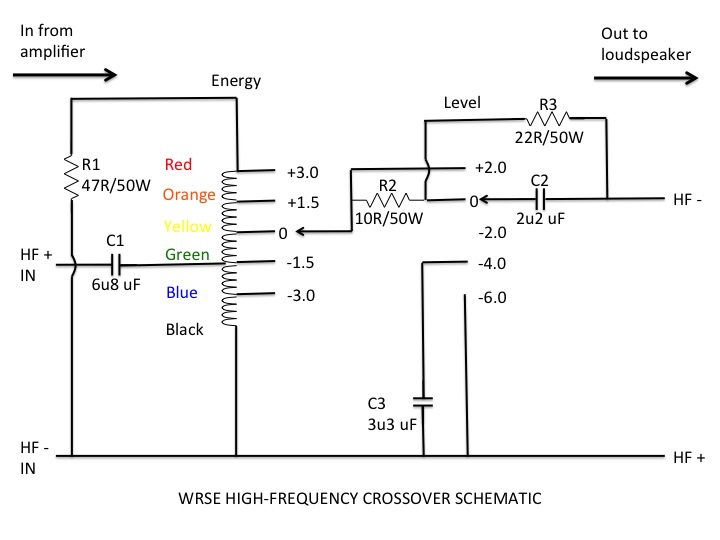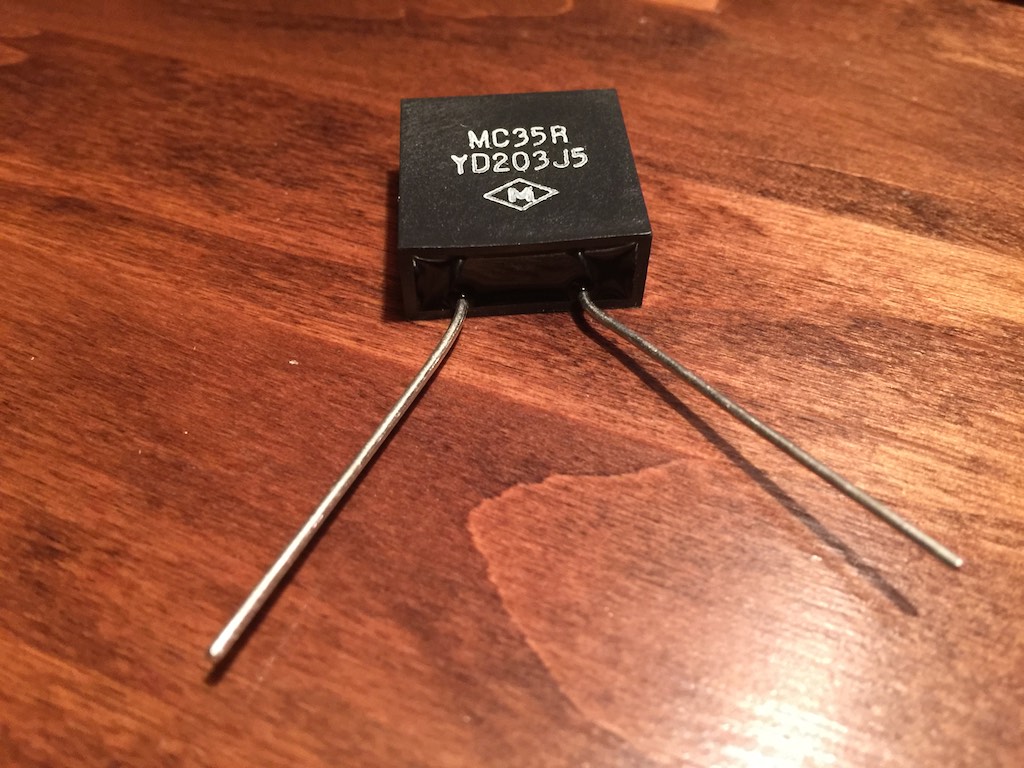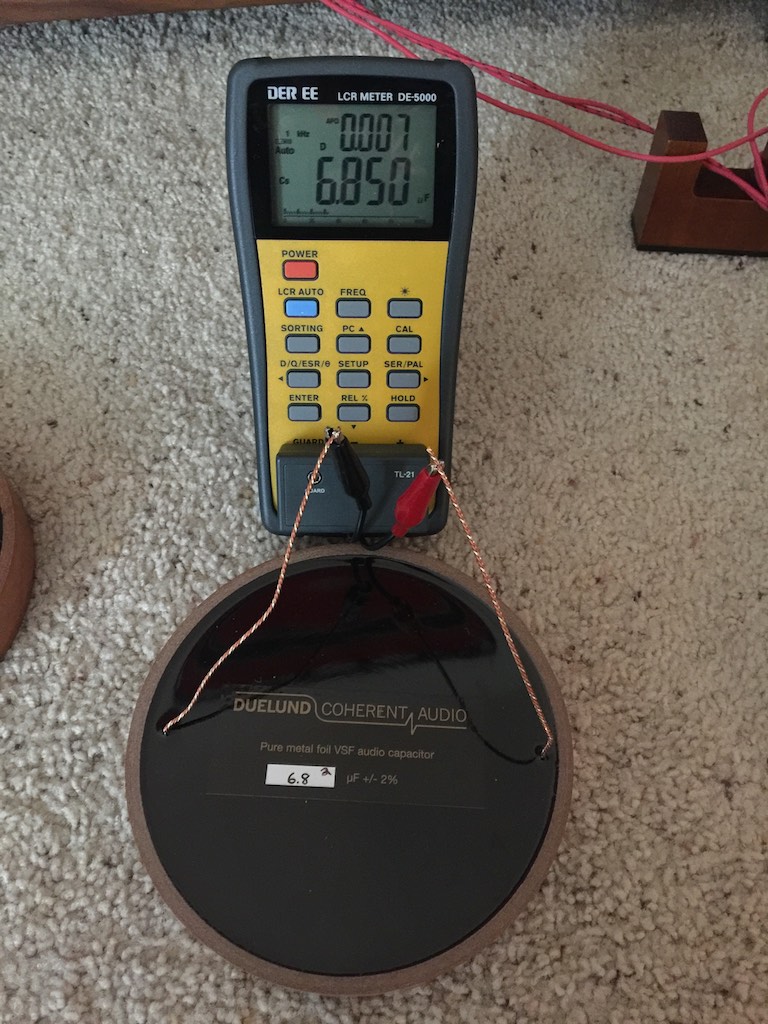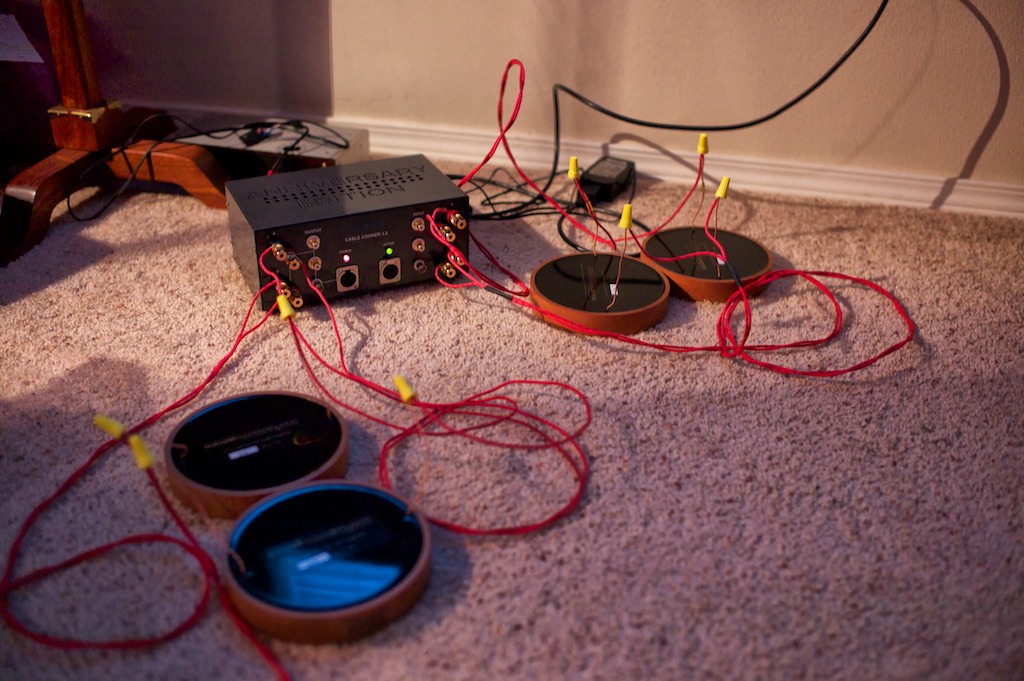I wanted to tell you a little more about the new 6.8uF Duelund CAST hybrid silver-copper capacitors from Frederik that I mentioned in this post.

6.8uF Duelund CAST hybrid copper-silver hybrid capacitors (left) and 6.8uF Duelund CAST copper capacitors (right)
As a refresher, let me remind you how the hand-crafted Duelund CAST silver & copper capacitors are made.
In the Duelund CAST capacitors Frederik uses only pure annealed soft copper or silver foil in natural paper and oil, along with resonance control both inside and outside the capacitor. A capacitor is made using two foils with paper between the foils, which results in capacitance being created in the electric field between them. Each Duelund CAST capacitor is completely hand made in an incredibly labor intensive process:
“Foils of pure copper or silver are initially wound with paper to a certain value that is a good deal over the needed capacitance. Then the foil is put under vacuum pressure in an oil tank at high temperature for about a week, so that everything inside the winding undergoes vacuum impregnation and is permeated by oil. When this process is done, the resulting foil is wound by hand in a humidity and temperature-controlled room to an exact specification, and then it is placed back into the oil. Immediately after this process the winding is sealed by the use of a special lacquer, which is also used in the yacht industry to seal against moisture. This takes another week. During this process a ring of vacuum impregnated paper has been readied with a base of our CAST material.”
“The winding is heated and then placed in the ring & base assembly and CAST material is poured on top of it in five stages, with air bubbles in the CAST material being forced out by applying a very precisely controlled flame to the surface (yes really!). This process takes another week. Following this step the capacitor is measured and checked (as it has been at every step along the way), and if everything is ok, then we ship it to the customer. The total production time is typically six to eight weeks.”
Other than their obvious high quality, one of the most striking aspects of the Duelund CAST capacitors are their large size and heavy weight, which is due to their perfectionist design using natural materials and pure metal foil – they simply have to be larger than mass produced capacitors.
Frederik says the careful selection of materials and this no holds barred style of design provides dramatic benefits for audio applications:
“From a performance standpoint, the main thing is an absolute lack of coloration, and a much more natural presentation – things don’t float around but stay locked in time and space. How you perceive and understand the layers in the music becomes greatly enhanced, primarily because of the sudden silence in between notes. Micro and macro dynamics take on a whole new meaning. Mr. Duelund would liken it to drinking Coke your entire life and then suddenly having a drink of pure water.”
Now let's talk about the construction of the new hybrid silver-copper Duelund CAST capacitors, which is a little different than I was expecting.
To help set the stage for the unique construction of these hybrid silver-copper Duelund CAST capacitors, let me tell you a little about the upcoming Altec A5 VOTT Adventure with Yazaki-san.
One of the ideas Yazaki-san has been telling me about for the A5 crossovers is the use of bypass capacitors to improve their performance (among other things, which I'll tell you all about in due time).
The use of bypass capacitors is fairly common way to hot-rod the performance of amplifiers, but you don't hear about it as much in the context of loudspeaker crossovers.
However, in some of the most cutting-edge crossover designs, bypass capacitors are used to get the highest level of performance possible, and that's what we are going to do in the Altec A5 VOTT Adventure crossovers.
In the context of my A5 VOTT or WRSE loudspeaker crossovers, a bypass capacitor is a capacitor that is of a small value relative to the capacitor being bypassed, and is placed in parallel with it.
So, for example, for a 6.8uF capacitor like that used in the C1 position of the Westminster's high-frequency crossovers (above), the bypass capacitor would only be a few hundredths of a micro-Farad.
For example, in similar applications in the Altec A5 VOTT Adventure crossovers we will be using 0.02 uF SPEC Ruby-Mica capacitors as bypass capacitors as shown above.
So what does a bypass capacitor do in a crossover? Essentially it filters out high-frequency noise and 'flavors' the capacitor it is bypassing in the circuit so that it sounds more like the bypass capacitor.
So let's say I take 0.02 uF SPEC ruby-mica capacitors to use as bypass capacitors for the C1 6.8uF Duelund CAST copper or silver capacitors in my WRSE crossovers. What would happen?
Well, essentially all of the good things about the 6.8uF Duelund CAST copper or silver capacitors would remain, but the high-frequencies would be filtered and have less noise, and would take on more of the sonic characteristics of the 0.02 uF SPEC ruby-mica capacitors.
From a more technical standpoint, my friend Ron put it like this:
"Without getting deeply into the math, let me say that a given capacitor has a falling impedance as frequency increases, but there are resistive and inductive components also in the full equation, as inductors have resistance, and resistors have capacitance & inductive components. Large capacitors have generally larger multipliers with frequency of these characteristics while smaller value caps have smaller value multipliers of inductive reactance and resistance with increasing frequency. In practice the parallel attachment of a smaller value capacitor around a larger value cap allows more suitable reduced undesirable reactance as frequency is increased. Subjectively sounding faster and more coherent as the balance of reactance allows capacitive reactance to dominate. Simplistically, caps in parallel increase reactance with frequency while inductors and resistors are inverse functions and decrease reactance when in parallel. As I understand the effect."
From a listener's standpoint, what you would hear as a result of using bypass caps is that your loudspeakers would sound more natural, smoother, faster, and more coherent.
It turns out that there's quite a lot of knowledge & expertise that goes into choosing the value & materials for the bypass capacitor in a application to get the particular aural results one wants to achieve.
Frederik told me, "We are not blind to the fact that pure silver capacitors get very expensive at larger capacitances like your 6.8uF Duelund CAST silver capacitors, so the idea was to try to recreate some of the silver capacitor's performance at a much lower cost. Quite a few of our customers like to bypass our larger CAST capacitors, so we thought that incorporating a small Duelund silver bypass capacitor into the CAST enclosure made the most sense to accomplish that. Over the years we’ve done this ourselves in custom orders for clients' speaker projects, so the idea to make a capacitor available that is pre-bypassed with a silver capacitor wasn’t entirely new, we just needed to be able to do a sufficient quantity of silver windings for it to be cost effective."
The 6.8uF Duelund CAST hybrid copper-silver capacitors incorporate a 0.015uF silver bypass capacitor (that's the hybrid part) into the 6.8uF Duelund CAST copper capacitor's potted enclosure. So inside the Duelund CAST hybrid silver-copper capacitor there are really two capacitors, the exotic copper foil capacitor that is being bypassed, as well as an equally exotic silver bypass capacitor. They are both potted together, which damps any resonance effects you might otherwise get.
If you look closely at the lead for the 6.8uF Duelund CAST hybrid silver-copper capacitor below, you can see intertwined leads from both the bypassed copper foil capacitor & the silver bypass capacitor hidden within the CAST potting. For the next blog post I'll try to get a clearer photo so you can see it better.
Just for fun I decided to measure the 6.8uF Duelund CAST hybrid silver-copper capacitors (and the Duelund CAST copper capacitors) with the DER EE DE-5000 handheld LCR meter that Yazaki-san sent me to use for the A5 VOTT crossover project (Thank you, Yazaki-san!).
Let me take a moment to tell you a little about the DER EE DE-5000 Handheld LCR Meter, and let you know that it is available on Amazon for $135 USD.
Here's a link to the owners manual for the DER EE DE-5000 in English (the one it comes with is in Japanese). Here's a link to a review of the DER EE DE-5000 Handheld LCR Meter out on the diyAudio website that is helpful and informative. Here's some YouTube reviews (1, 2, 3) of the DER EE DE-5000. Here's a link to a YouTube video about a teardown of the DE-5000.
The DER EE DE-5000 is a true full-featured handheld LCR meter (not to be confused with a multimeter) that also allows you to measure phase angle (θ), dissipation factor (D), equivalent series resistance and parallel equivalent resistance (ESR/Rp), quality factor (Q), series and parallel inductance (Ls/Lp), series and parallel capacitance (Cs/Cp), series and parallel resistance (ac) (Rs/Rp), and series and parallel resistance (dc) (Rdc/Rp), over a range of test frequencies (DC, 100Hz, 120Hz, 1kHz, 10kHz, and 100kHz).
My friend Ron told me that until recently an LCR meter that was capable of doing what the DE-5000 can do was very expensive.
I'm just learning how to use it, so bear with me on the occasional mistakes that will inevitably occur, but I'll do my best to correct them as I go. I'll be telling you more about using this for audio projects as we proceed with our crossover adventures.
Here's what I measured for the 6.8uF Duelund CAST capacitors in the auto capacitance mode with a testing frequency of 1kHz:
Duelund CAST Cu #1: 6.856 uF, D of 0.004, Q of 205, ESR of 0.11 Ohm, and a θ of -89.7
Duelund CAST Cu #2: 6.859 uF, D of 0.005, Q of 171.6, ESR of 0.13 Ohm, and a θ of -89.6
Duelund CAST Cu-Ag #1: 6.846 uF, D of 0.009, Q of 109.7, ESR of 0.21 Ohm, and a θ of -89.4
Duelund CAST Cu-Ag #2: 6.853 uF, D of 0.007, Q of 130.5, ESR of 0.17 Ohm, and a θ of -89.5
I haven't had a chance to measure the pure silver foil Duelund CAST capacitors yet, but when I do I'll report back.
I have been conditioning the new 6.8uF Duelund CAST hybrid copper-silver capacitors that Frederik sent me to try for about a week now on my Audiodharma Cable Cooker.
I also conditioned the 6.8uF Duelund CAST copper capacitors that I wrote about in the Duelund-WRSE Project (1, 2) along with them to use as a reference.
Will the 6.8uF Duelund CAST hybrid silver-copper capacitor come close to the 6.8uF Duelund CAST silver capacitor's performance? How will it compare to the 6.8uF Duelund CAST copper capacitor's performance?
I hope to be able to provide some listening impressions over the next few days, so stay tuned!
Thanks for stopping by!




